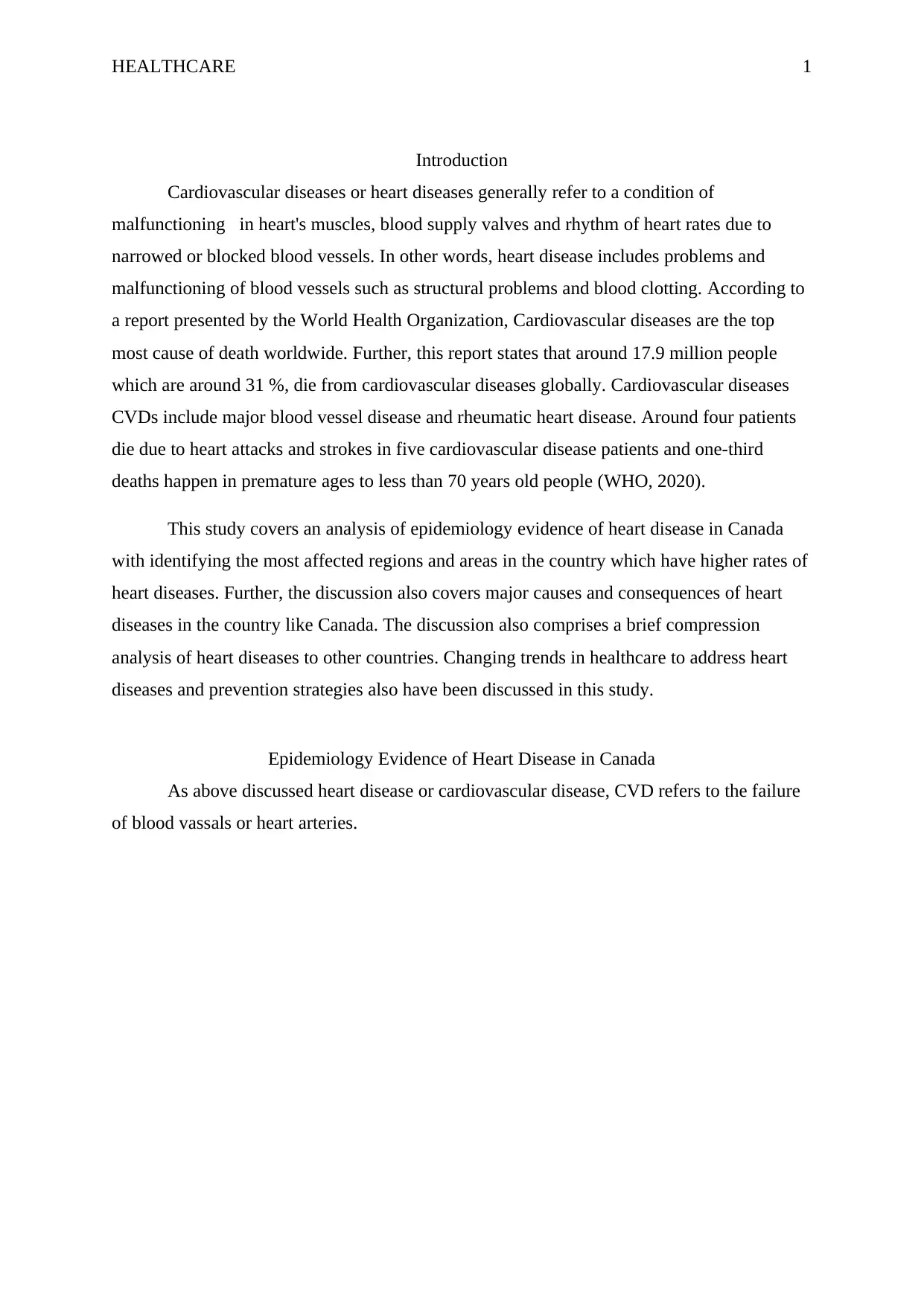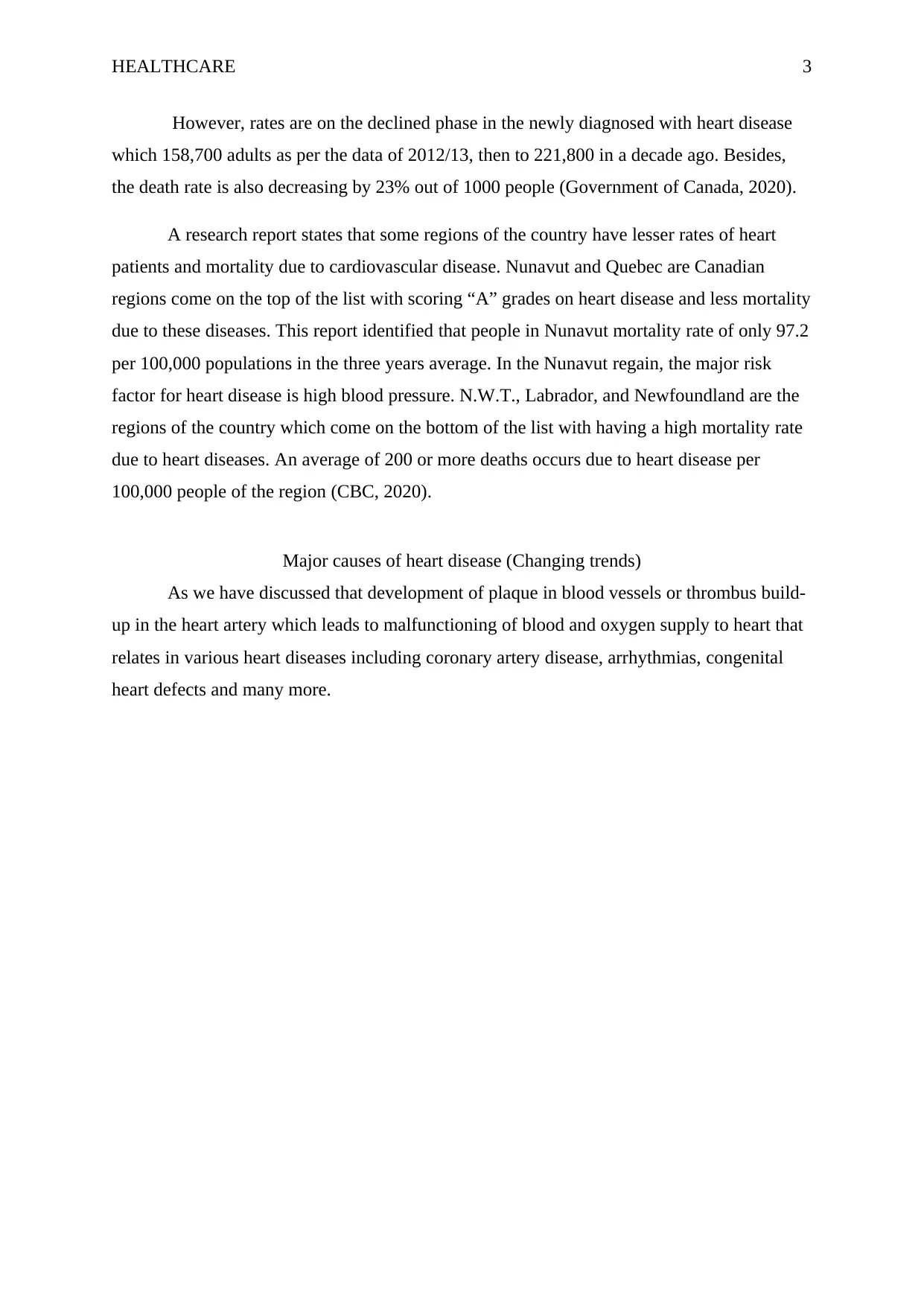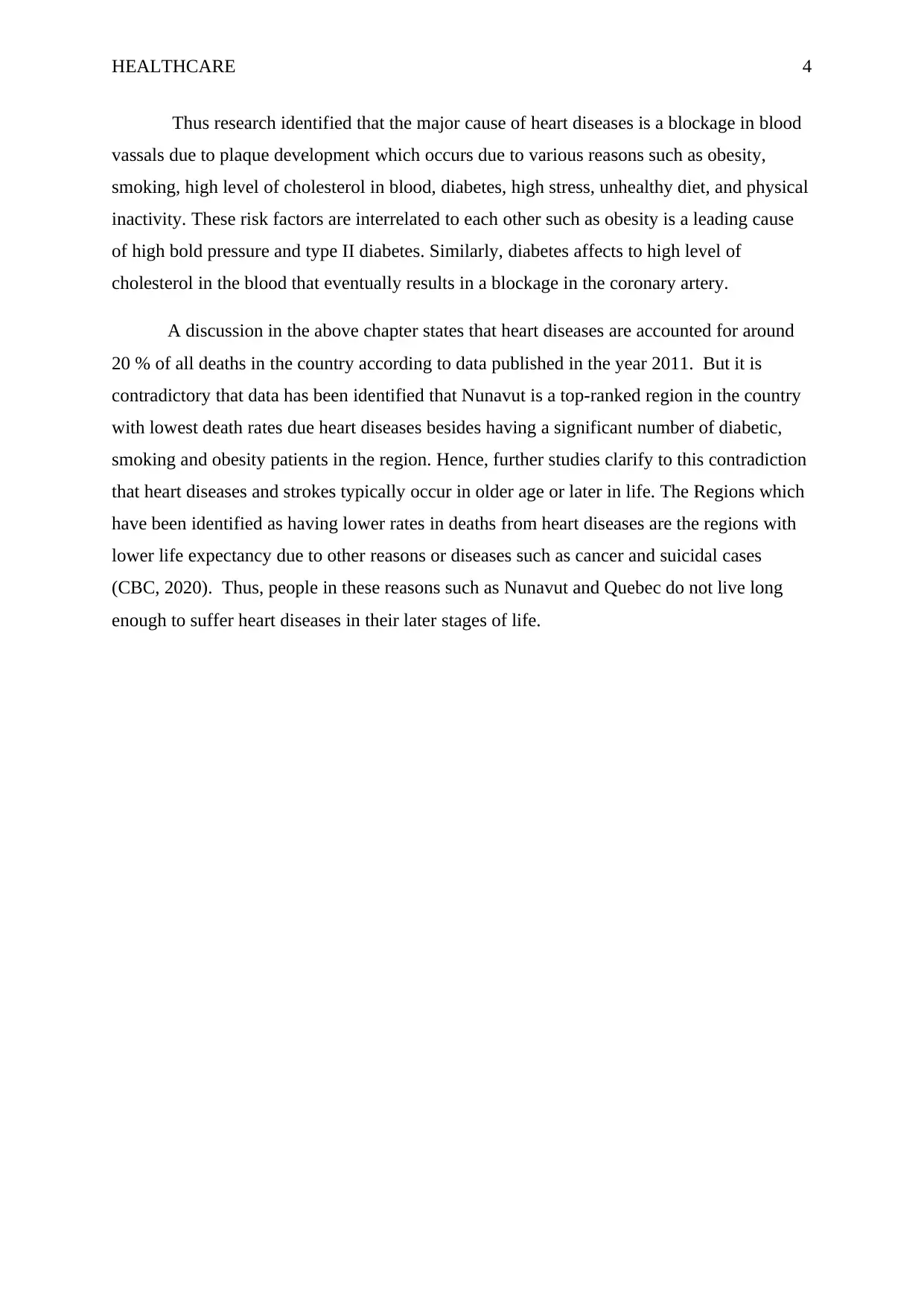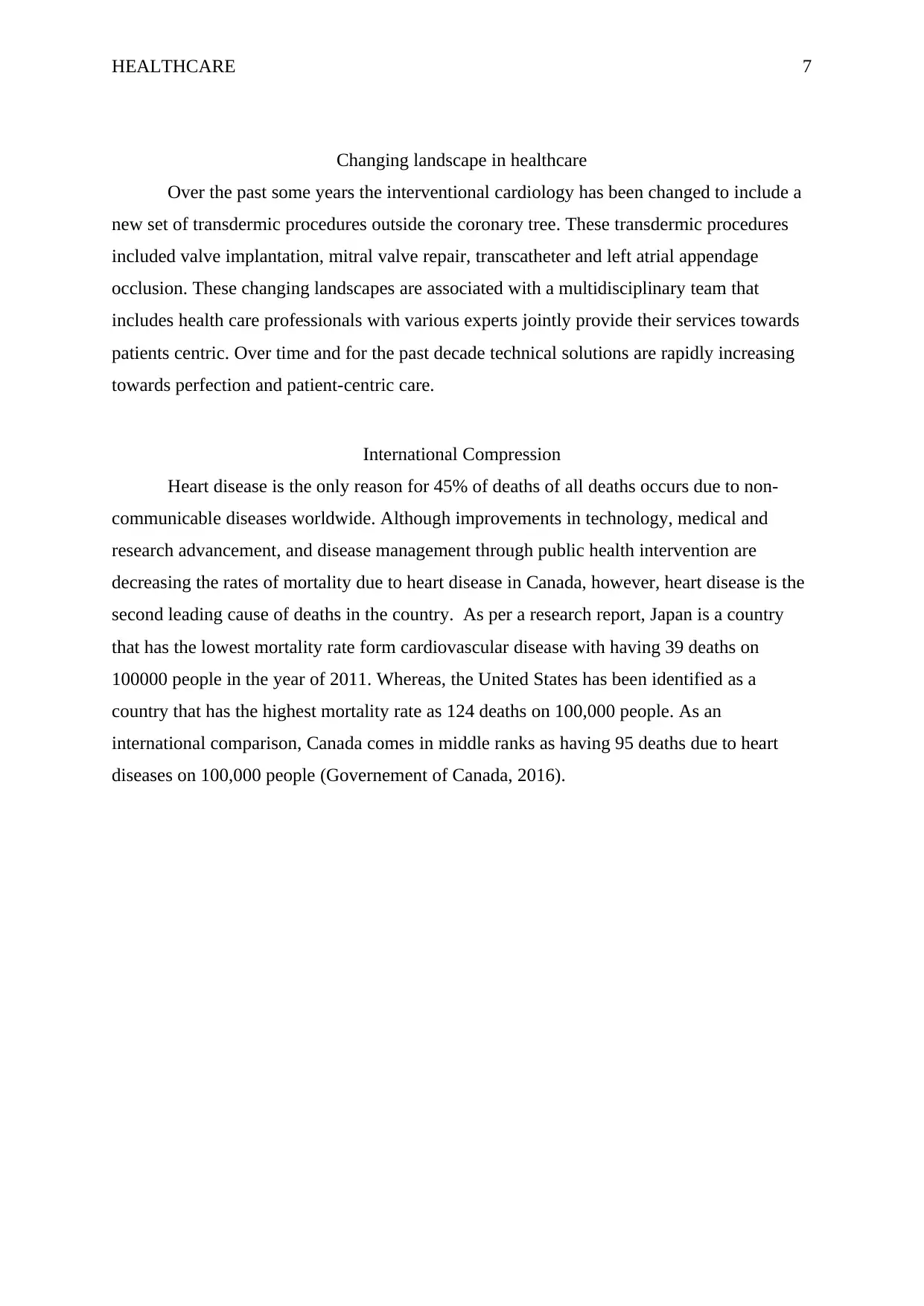Health Care in Canada Report 2022
VerifiedAdded on 2022/08/12
|12
|2430
|22
Assignment
AI Summary
Contribute Materials
Your contribution can guide someone’s learning journey. Share your
documents today.

HEALTHCARE 0
Healthcare in Canada
Student Details
Healthcare in Canada
Student Details
Secure Best Marks with AI Grader
Need help grading? Try our AI Grader for instant feedback on your assignments.

HEALTHCARE
Table of Contents
Introduction................................................................................................................................1
Epidemiology Evidence of Heart Disease in Canada................................................................1
Major causes of heart disease (Changing trends).......................................................................2
Consequences of heart disease...................................................................................................3
Prevention and Recovery strategies...........................................................................................3
Changing landscape in healthcare..............................................................................................4
International Compression.........................................................................................................4
Conclusion..................................................................................................................................5
Table of Contents
Introduction................................................................................................................................1
Epidemiology Evidence of Heart Disease in Canada................................................................1
Major causes of heart disease (Changing trends).......................................................................2
Consequences of heart disease...................................................................................................3
Prevention and Recovery strategies...........................................................................................3
Changing landscape in healthcare..............................................................................................4
International Compression.........................................................................................................4
Conclusion..................................................................................................................................5

HEALTHCARE 1
Introduction
Cardiovascular diseases or heart diseases generally refer to a condition of
malfunctioning in heart's muscles, blood supply valves and rhythm of heart rates due to
narrowed or blocked blood vessels. In other words, heart disease includes problems and
malfunctioning of blood vessels such as structural problems and blood clotting. According to
a report presented by the World Health Organization, Cardiovascular diseases are the top
most cause of death worldwide. Further, this report states that around 17.9 million people
which are around 31 %, die from cardiovascular diseases globally. Cardiovascular diseases
CVDs include major blood vessel disease and rheumatic heart disease. Around four patients
die due to heart attacks and strokes in five cardiovascular disease patients and one-third
deaths happen in premature ages to less than 70 years old people (WHO, 2020).
This study covers an analysis of epidemiology evidence of heart disease in Canada
with identifying the most affected regions and areas in the country which have higher rates of
heart diseases. Further, the discussion also covers major causes and consequences of heart
diseases in the country like Canada. The discussion also comprises a brief compression
analysis of heart diseases to other countries. Changing trends in healthcare to address heart
diseases and prevention strategies also have been discussed in this study.
Epidemiology Evidence of Heart Disease in Canada
As above discussed heart disease or cardiovascular disease, CVD refers to the failure
of blood vassals or heart arteries.
Introduction
Cardiovascular diseases or heart diseases generally refer to a condition of
malfunctioning in heart's muscles, blood supply valves and rhythm of heart rates due to
narrowed or blocked blood vessels. In other words, heart disease includes problems and
malfunctioning of blood vessels such as structural problems and blood clotting. According to
a report presented by the World Health Organization, Cardiovascular diseases are the top
most cause of death worldwide. Further, this report states that around 17.9 million people
which are around 31 %, die from cardiovascular diseases globally. Cardiovascular diseases
CVDs include major blood vessel disease and rheumatic heart disease. Around four patients
die due to heart attacks and strokes in five cardiovascular disease patients and one-third
deaths happen in premature ages to less than 70 years old people (WHO, 2020).
This study covers an analysis of epidemiology evidence of heart disease in Canada
with identifying the most affected regions and areas in the country which have higher rates of
heart diseases. Further, the discussion also covers major causes and consequences of heart
diseases in the country like Canada. The discussion also comprises a brief compression
analysis of heart diseases to other countries. Changing trends in healthcare to address heart
diseases and prevention strategies also have been discussed in this study.
Epidemiology Evidence of Heart Disease in Canada
As above discussed heart disease or cardiovascular disease, CVD refers to the failure
of blood vassals or heart arteries.

HEALTHCARE 2
The heart disease occurs due to buildup of plaque in blood vessels or heart's arteries
which lead to blockages of blood flow to the heart and due to deprived of oxygen heart stops
to work and results in the death of the person. In Canada, heart disease is the second most
cause of death of people in recent years. According to a report presented by the Government
of Canada around 2.4 million or 8.5%, adults aged 20 years and older are living with
diagnosed heart disease and 2.1% with a history of a heart attack. Around 669,600 (3.6%)
Canadian people aged 40 years and older are living with diagnosed heart issues or failure
(Government of Canada, 2020).
The mortality rate is three times higher in the people who are aged to 20 years and
older and living with heart disease than those who are living without any heart disease. While
it is four times higher among people aged 20 years and older having a heart attack as
compared to people who have not. These rates increase with the ages of people and the
mortality rate is six times higher among people who are at the age of forty and older in
Canada.
Apart from age, gender is also the most influencing factor to affects heart disease and
mortality rate. Men are at two times higher risk of heart disease than to women and the most
prone age of heart disease are 55-64 years in men which is 65-74 years in women.
The heart disease occurs due to buildup of plaque in blood vessels or heart's arteries
which lead to blockages of blood flow to the heart and due to deprived of oxygen heart stops
to work and results in the death of the person. In Canada, heart disease is the second most
cause of death of people in recent years. According to a report presented by the Government
of Canada around 2.4 million or 8.5%, adults aged 20 years and older are living with
diagnosed heart disease and 2.1% with a history of a heart attack. Around 669,600 (3.6%)
Canadian people aged 40 years and older are living with diagnosed heart issues or failure
(Government of Canada, 2020).
The mortality rate is three times higher in the people who are aged to 20 years and
older and living with heart disease than those who are living without any heart disease. While
it is four times higher among people aged 20 years and older having a heart attack as
compared to people who have not. These rates increase with the ages of people and the
mortality rate is six times higher among people who are at the age of forty and older in
Canada.
Apart from age, gender is also the most influencing factor to affects heart disease and
mortality rate. Men are at two times higher risk of heart disease than to women and the most
prone age of heart disease are 55-64 years in men which is 65-74 years in women.
Secure Best Marks with AI Grader
Need help grading? Try our AI Grader for instant feedback on your assignments.

HEALTHCARE 3
However, rates are on the declined phase in the newly diagnosed with heart disease
which 158,700 adults as per the data of 2012/13, then to 221,800 in a decade ago. Besides,
the death rate is also decreasing by 23% out of 1000 people (Government of Canada, 2020).
A research report states that some regions of the country have lesser rates of heart
patients and mortality due to cardiovascular disease. Nunavut and Quebec are Canadian
regions come on the top of the list with scoring “A” grades on heart disease and less mortality
due to these diseases. This report identified that people in Nunavut mortality rate of only 97.2
per 100,000 populations in the three years average. In the Nunavut regain, the major risk
factor for heart disease is high blood pressure. N.W.T., Labrador, and Newfoundland are the
regions of the country which come on the bottom of the list with having a high mortality rate
due to heart diseases. An average of 200 or more deaths occurs due to heart disease per
100,000 people of the region (CBC, 2020).
Major causes of heart disease (Changing trends)
As we have discussed that development of plaque in blood vessels or thrombus build-
up in the heart artery which leads to malfunctioning of blood and oxygen supply to heart that
relates in various heart diseases including coronary artery disease, arrhythmias, congenital
heart defects and many more.
However, rates are on the declined phase in the newly diagnosed with heart disease
which 158,700 adults as per the data of 2012/13, then to 221,800 in a decade ago. Besides,
the death rate is also decreasing by 23% out of 1000 people (Government of Canada, 2020).
A research report states that some regions of the country have lesser rates of heart
patients and mortality due to cardiovascular disease. Nunavut and Quebec are Canadian
regions come on the top of the list with scoring “A” grades on heart disease and less mortality
due to these diseases. This report identified that people in Nunavut mortality rate of only 97.2
per 100,000 populations in the three years average. In the Nunavut regain, the major risk
factor for heart disease is high blood pressure. N.W.T., Labrador, and Newfoundland are the
regions of the country which come on the bottom of the list with having a high mortality rate
due to heart diseases. An average of 200 or more deaths occurs due to heart disease per
100,000 people of the region (CBC, 2020).
Major causes of heart disease (Changing trends)
As we have discussed that development of plaque in blood vessels or thrombus build-
up in the heart artery which leads to malfunctioning of blood and oxygen supply to heart that
relates in various heart diseases including coronary artery disease, arrhythmias, congenital
heart defects and many more.

HEALTHCARE 4
Thus research identified that the major cause of heart diseases is a blockage in blood
vassals due to plaque development which occurs due to various reasons such as obesity,
smoking, high level of cholesterol in blood, diabetes, high stress, unhealthy diet, and physical
inactivity. These risk factors are interrelated to each other such as obesity is a leading cause
of high bold pressure and type II diabetes. Similarly, diabetes affects to high level of
cholesterol in the blood that eventually results in a blockage in the coronary artery.
A discussion in the above chapter states that heart diseases are accounted for around
20 % of all deaths in the country according to data published in the year 2011. But it is
contradictory that data has been identified that Nunavut is a top-ranked region in the country
with lowest death rates due heart diseases besides having a significant number of diabetic,
smoking and obesity patients in the region. Hence, further studies clarify to this contradiction
that heart diseases and strokes typically occur in older age or later in life. The Regions which
have been identified as having lower rates in deaths from heart diseases are the regions with
lower life expectancy due to other reasons or diseases such as cancer and suicidal cases
(CBC, 2020). Thus, people in these reasons such as Nunavut and Quebec do not live long
enough to suffer heart diseases in their later stages of life.
Thus research identified that the major cause of heart diseases is a blockage in blood
vassals due to plaque development which occurs due to various reasons such as obesity,
smoking, high level of cholesterol in blood, diabetes, high stress, unhealthy diet, and physical
inactivity. These risk factors are interrelated to each other such as obesity is a leading cause
of high bold pressure and type II diabetes. Similarly, diabetes affects to high level of
cholesterol in the blood that eventually results in a blockage in the coronary artery.
A discussion in the above chapter states that heart diseases are accounted for around
20 % of all deaths in the country according to data published in the year 2011. But it is
contradictory that data has been identified that Nunavut is a top-ranked region in the country
with lowest death rates due heart diseases besides having a significant number of diabetic,
smoking and obesity patients in the region. Hence, further studies clarify to this contradiction
that heart diseases and strokes typically occur in older age or later in life. The Regions which
have been identified as having lower rates in deaths from heart diseases are the regions with
lower life expectancy due to other reasons or diseases such as cancer and suicidal cases
(CBC, 2020). Thus, people in these reasons such as Nunavut and Quebec do not live long
enough to suffer heart diseases in their later stages of life.

HEALTHCARE 5
Consequences of heart disease
The health care system of Canada is overburdened with deaths due to heart disease. In
the country, the second leading cause of deaths and hospitalization is heart disease. The major
consequence of heart diseases in the country is the death of people (Robitaille, McRae, &
Toews, 2017). By the year 2005, the deaths proportion associated with heart disease was
around 61% for males and nearby 41 % percent was for females. It was also estimated that by
the year 2020 the ratio will increases by 67% and 46 % respectively for males and females
(Thériault, Stonebridge, & Browarski, 2010). Besides, the high burden of heart diseases on
the Canadian health care system leading to huge economic expenditures of the country.
According to a research report reduction in mortality rate due to heart diseases will be
effective in cost-saving. Between the years of 2012- 2025, reduction of heart diseases by 25%
will lead redaction on the cost by 7 percent on the physician and around 9 percent on
hospitalizations. This will be a huge amount for the healthcare department of the country
which is currently spending on heart disease. As discussed earlier that there is a significant
number of adults who have been diagnosed and suffering from heart diseases. Thus, deaths of
people at an early age or in adulthood are putting a strain on the economic growth of the
country. Adulthood deaths are eventually decreasing the younger and productive population
in Canada which is directly related to economic losses of the country.
Consequences of heart disease
The health care system of Canada is overburdened with deaths due to heart disease. In
the country, the second leading cause of deaths and hospitalization is heart disease. The major
consequence of heart diseases in the country is the death of people (Robitaille, McRae, &
Toews, 2017). By the year 2005, the deaths proportion associated with heart disease was
around 61% for males and nearby 41 % percent was for females. It was also estimated that by
the year 2020 the ratio will increases by 67% and 46 % respectively for males and females
(Thériault, Stonebridge, & Browarski, 2010). Besides, the high burden of heart diseases on
the Canadian health care system leading to huge economic expenditures of the country.
According to a research report reduction in mortality rate due to heart diseases will be
effective in cost-saving. Between the years of 2012- 2025, reduction of heart diseases by 25%
will lead redaction on the cost by 7 percent on the physician and around 9 percent on
hospitalizations. This will be a huge amount for the healthcare department of the country
which is currently spending on heart disease. As discussed earlier that there is a significant
number of adults who have been diagnosed and suffering from heart diseases. Thus, deaths of
people at an early age or in adulthood are putting a strain on the economic growth of the
country. Adulthood deaths are eventually decreasing the younger and productive population
in Canada which is directly related to economic losses of the country.
Paraphrase This Document
Need a fresh take? Get an instant paraphrase of this document with our AI Paraphraser

HEALTHCARE 6
Prevention and Recovery strategies
As we already discussed that smoking, consumption of alcohol, inactive lifestyle, and
unhealthy lifestyle and are the major cause of the triggers to the most affecting factors of
heart diseases such as high blood pressure, high level of cholesterol and obesity. Although
primary and secondary prevention of heart disease is suboptimal throughout the globe,
however, there is some evidence that some practices help to create the gaps between
mortality and heart diseases. Hence several factors reduce the risk of heart disease to people.
As studies identified that smoking or tobacco consumption is directly hit to heart and blood
vessels. Chemical in tobacco and smoke reduces the level of oxygen in the blood which
triggers blood pressure and heart rate because the lack of oxygen and in this condition heart
works hard to supply oxygen to the brain and whole body. Hence, it is important for the
people that by the avoidance of smoking people may prevent heart diseases avoid smoking
(Stallones, 2015). Another factor that triggers heart diseases is an inactive or sedentary
lifestyle. An inactive or sedentary lifestyle increases blood pressure and obesity that leads to
a direct adverse impact on heart functions. Thus, it is important to add some physical
activities such as walking, exercising and running in daily routine to prevent and reduce risk
factors that are associated with heart diseases.
Besides some lifestyle changes such as low intake of high cholesterol diet, by avoid
alcohol consumption, increase intake of green vegetables and fruits, and lowering stress
factors will help to prevent heart disease.
Prevention and Recovery strategies
As we already discussed that smoking, consumption of alcohol, inactive lifestyle, and
unhealthy lifestyle and are the major cause of the triggers to the most affecting factors of
heart diseases such as high blood pressure, high level of cholesterol and obesity. Although
primary and secondary prevention of heart disease is suboptimal throughout the globe,
however, there is some evidence that some practices help to create the gaps between
mortality and heart diseases. Hence several factors reduce the risk of heart disease to people.
As studies identified that smoking or tobacco consumption is directly hit to heart and blood
vessels. Chemical in tobacco and smoke reduces the level of oxygen in the blood which
triggers blood pressure and heart rate because the lack of oxygen and in this condition heart
works hard to supply oxygen to the brain and whole body. Hence, it is important for the
people that by the avoidance of smoking people may prevent heart diseases avoid smoking
(Stallones, 2015). Another factor that triggers heart diseases is an inactive or sedentary
lifestyle. An inactive or sedentary lifestyle increases blood pressure and obesity that leads to
a direct adverse impact on heart functions. Thus, it is important to add some physical
activities such as walking, exercising and running in daily routine to prevent and reduce risk
factors that are associated with heart diseases.
Besides some lifestyle changes such as low intake of high cholesterol diet, by avoid
alcohol consumption, increase intake of green vegetables and fruits, and lowering stress
factors will help to prevent heart disease.

HEALTHCARE 7
Changing landscape in healthcare
Over the past some years the interventional cardiology has been changed to include a
new set of transdermic procedures outside the coronary tree. These transdermic procedures
included valve implantation, mitral valve repair, transcatheter and left atrial appendage
occlusion. These changing landscapes are associated with a multidisciplinary team that
includes health care professionals with various experts jointly provide their services towards
patients centric. Over time and for the past decade technical solutions are rapidly increasing
towards perfection and patient-centric care.
International Compression
Heart disease is the only reason for 45% of deaths of all deaths occurs due to non-
communicable diseases worldwide. Although improvements in technology, medical and
research advancement, and disease management through public health intervention are
decreasing the rates of mortality due to heart disease in Canada, however, heart disease is the
second leading cause of deaths in the country. As per a research report, Japan is a country
that has the lowest mortality rate form cardiovascular disease with having 39 deaths on
100000 people in the year of 2011. Whereas, the United States has been identified as a
country that has the highest mortality rate as 124 deaths on 100,000 people. As an
international comparison, Canada comes in middle ranks as having 95 deaths due to heart
diseases on 100,000 people (Governement of Canada, 2016).
Changing landscape in healthcare
Over the past some years the interventional cardiology has been changed to include a
new set of transdermic procedures outside the coronary tree. These transdermic procedures
included valve implantation, mitral valve repair, transcatheter and left atrial appendage
occlusion. These changing landscapes are associated with a multidisciplinary team that
includes health care professionals with various experts jointly provide their services towards
patients centric. Over time and for the past decade technical solutions are rapidly increasing
towards perfection and patient-centric care.
International Compression
Heart disease is the only reason for 45% of deaths of all deaths occurs due to non-
communicable diseases worldwide. Although improvements in technology, medical and
research advancement, and disease management through public health intervention are
decreasing the rates of mortality due to heart disease in Canada, however, heart disease is the
second leading cause of deaths in the country. As per a research report, Japan is a country
that has the lowest mortality rate form cardiovascular disease with having 39 deaths on
100000 people in the year of 2011. Whereas, the United States has been identified as a
country that has the highest mortality rate as 124 deaths on 100,000 people. As an
international comparison, Canada comes in middle ranks as having 95 deaths due to heart
diseases on 100,000 people (Governement of Canada, 2016).

HEALTHCARE 8
Conclusion
Heart disease or cardiovascular diseases are the major factors behind the deaths all
around the world. It has been identified that heart diseases lead to around half of all deaths of
non-communicable diseases in the world. Canada is a country most likely to live, has been
ranked 2nd on mortality rates due to heart disease. Statistics of past decades show that despite
slight declines in mortality rates, heart disease is gulping many lives every year in the country
and around the globe. The research data revealed that there is a significant difference between
male and female mortality and male are on higher risk as per to females besides some area of
the country have been identified with high mortality due to heart diseases such as N.W.T.,
Labrador, and Newfoundland as a comparison to Nunavut and Quebec.
This study also discussed causes and prevention from heart disease. Smoking, obesity,
high level of cholesterol, high blood pressure and stress are the major causes and by avoiding
and working on these factors we can prevent the risk of heart diseases at a certain level. This
study also discovered some changing landscapes in healthcare-related to heart diseases such
as technology and medical advancement. International comparison has been identified that
Japan has the lowest mortality rate and the US comes on the first of the list due to heart
disease.
Conclusion
Heart disease or cardiovascular diseases are the major factors behind the deaths all
around the world. It has been identified that heart diseases lead to around half of all deaths of
non-communicable diseases in the world. Canada is a country most likely to live, has been
ranked 2nd on mortality rates due to heart disease. Statistics of past decades show that despite
slight declines in mortality rates, heart disease is gulping many lives every year in the country
and around the globe. The research data revealed that there is a significant difference between
male and female mortality and male are on higher risk as per to females besides some area of
the country have been identified with high mortality due to heart diseases such as N.W.T.,
Labrador, and Newfoundland as a comparison to Nunavut and Quebec.
This study also discussed causes and prevention from heart disease. Smoking, obesity,
high level of cholesterol, high blood pressure and stress are the major causes and by avoiding
and working on these factors we can prevent the risk of heart diseases at a certain level. This
study also discovered some changing landscapes in healthcare-related to heart diseases such
as technology and medical advancement. International comparison has been identified that
Japan has the lowest mortality rate and the US comes on the first of the list due to heart
disease.
Secure Best Marks with AI Grader
Need help grading? Try our AI Grader for instant feedback on your assignments.

HEALTHCARE 9
Bibliography
CBC. (2020). Mortality Due to Heart Disease and Stroke. Retrieved February 27, 2020, from
The conference Board of Canada:
https://www.conferenceboard.ca/hcp/provincial/health/heart.aspx?
AspxAutoDetectCookieSupport=1
Governement of Canada. (2016). Health Status of Canadians 2016: Report of the Chief
Public Health Officer - How are we unhealthy? - Cardiovascular disease. Retrieved
February 28, 2020, from Governement of Canada: https://www.canada.ca/en/public-
health/corporate/publications/chief-public-health-officer-reports-state-public-health-
canada/2016-health-status-canadians/page-17-how-are-we-unhealthy-cardiovascular-
disease.html
Government of Canada. (2020). Heart Disease in Canada. Retrieved February 27, 2020,
from Publications: Diseases and conditions:
https://www.canada.ca/en/public-health/services/publications/diseases-conditions/
heart-disease-canada.html
Government of Canada. (2020). Heart disease in Canada: Highlights from the Canadian
Chronic Disease Surveillance System. Retrieved February 27, 2020, from
Government of Canada:
https://www.canada.ca/en/public-health/services/publications/diseases-conditions/
heart-disease-canada-fact-sheet.html
Robitaille, C., McRae, L., & Toews, J. (2017). MONITORING THE BURDEN OF HEART
DISEASE WITH THE CANADIAN CHRONIC DISEASE SURVEILLANCE
SYSTEM. Canadian Journal of Cardiology, 138-139.
Stallones, A. R. (2015). The association between tobacco smoking and coronary heart
disease. International Journal of Epidemiology, 735–743.
Thériault, L., Stonebridge, C., & Browarski, S. (2010). The Canadian Heart Health Strategy:
Risk Factors and Future Cost Implications. Ottawa: The Conference Board of
Canada.
Bibliography
CBC. (2020). Mortality Due to Heart Disease and Stroke. Retrieved February 27, 2020, from
The conference Board of Canada:
https://www.conferenceboard.ca/hcp/provincial/health/heart.aspx?
AspxAutoDetectCookieSupport=1
Governement of Canada. (2016). Health Status of Canadians 2016: Report of the Chief
Public Health Officer - How are we unhealthy? - Cardiovascular disease. Retrieved
February 28, 2020, from Governement of Canada: https://www.canada.ca/en/public-
health/corporate/publications/chief-public-health-officer-reports-state-public-health-
canada/2016-health-status-canadians/page-17-how-are-we-unhealthy-cardiovascular-
disease.html
Government of Canada. (2020). Heart Disease in Canada. Retrieved February 27, 2020,
from Publications: Diseases and conditions:
https://www.canada.ca/en/public-health/services/publications/diseases-conditions/
heart-disease-canada.html
Government of Canada. (2020). Heart disease in Canada: Highlights from the Canadian
Chronic Disease Surveillance System. Retrieved February 27, 2020, from
Government of Canada:
https://www.canada.ca/en/public-health/services/publications/diseases-conditions/
heart-disease-canada-fact-sheet.html
Robitaille, C., McRae, L., & Toews, J. (2017). MONITORING THE BURDEN OF HEART
DISEASE WITH THE CANADIAN CHRONIC DISEASE SURVEILLANCE
SYSTEM. Canadian Journal of Cardiology, 138-139.
Stallones, A. R. (2015). The association between tobacco smoking and coronary heart
disease. International Journal of Epidemiology, 735–743.
Thériault, L., Stonebridge, C., & Browarski, S. (2010). The Canadian Heart Health Strategy:
Risk Factors and Future Cost Implications. Ottawa: The Conference Board of
Canada.

HEALTHCARE 10
WHO. (2020). Cardiovascular Diseases. Retrieved February 27, 2020, from The World
Health Organisation:
https://www.who.int/health-topics/cardiovascular-diseases/#tab=tab_1
WHO. (2020). Cardiovascular Diseases. Retrieved February 27, 2020, from The World
Health Organisation:
https://www.who.int/health-topics/cardiovascular-diseases/#tab=tab_1
1 out of 12
Related Documents
Your All-in-One AI-Powered Toolkit for Academic Success.
+13062052269
info@desklib.com
Available 24*7 on WhatsApp / Email
![[object Object]](/_next/static/media/star-bottom.7253800d.svg)
Unlock your academic potential
© 2024 | Zucol Services PVT LTD | All rights reserved.





